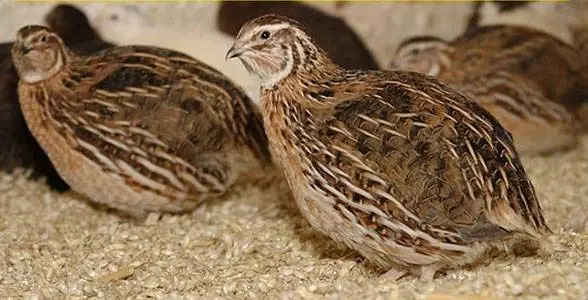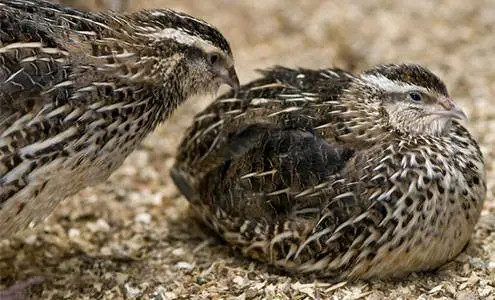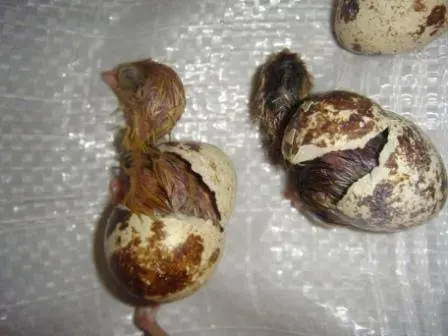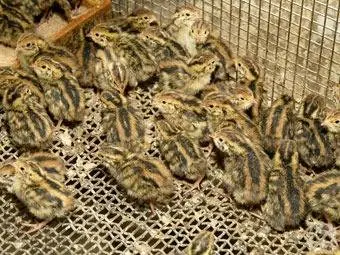Contents
One of the best egg-bearing quail breeds, Japanese quail, came to the USSR from Japan in the middle of the last century. It was from the country from which this breed was imported into the Union that the quail got its name.
The Japanese breed of quail, descended from the species “common quail”, is the ancestor of all other cultivated breeds that arose either as a result of fixing random mutations or due to selection for the desired trait.

Description of the Japanese quail
Japanese quails are quite large birds compared to their wild ancestor. If the “savage” weighs up to 145 g, then the “Japanese” already reaches 200 g. True, in exceptional cases. Usually the weight of quails is 120 g, quails are 140 g.
The selection of Japanese quails was aimed at increasing egg production and body weight in order to obtain dietary meat, so the wild form of the quail cannot be distinguished from the domesticated “Japanese” by color.
The color of the Japanese quail varies somewhat from darker to lighter, which made it possible to breed quails with colored plumage.
Previously, Japanese quail was bred on an industrial scale not only for eggs, but also for meat. Today, with the advent of larger breeds of quail, the meat value of Japanese quail has declined.
After the need arose to obtain a larger carcass from a quail, as a result of selection work in the USA, a breed of quail called the pharaoh was bred. The weight of the carcass of the quail pharaoh exceeds 300 g. The plumage, which is no different from the wild form of the quail, is considered by many experts to be a disadvantage of the pharaoh breed. But scammers, on the contrary, are a boon.

In the reviews of many buyers of Pharaoh quails, there are complaints that the bird will turn out to be small. Those who are more experienced, by the rate of growth of quails and their weight gain, quickly guess that instead of pharaohs, they were sold quails of the Japanese breed. As a rule, situations “on the contrary” do not happen. The quail Pharaoh is a more whimsical bird and carries fewer eggs than the “Japanese”, it is harder and more expensive to breed the original quail breed.
Productivity characteristics
Japanese quail begins to lay as early as the second month of life and is capable of laying up to 250 eggs per year. The weight of Japanese quail eggs is up to 10 g. With a small weight, today the meat carcasses of Japanese quail are no longer relevant, although this largely depends on taste. The weight of carcasses of wild pigeons is less than the weight of quail carcasses. And in a plucked and gutted thrush, there is even nothing to eat. However, both the thrush and the wild pigeon are objects of hunting.
A domesticated Japanese quail actively lays eggs directly on the floor, and always at the same time. But to make her sit on her eggs is an impossible task. Japanese quail after domestication completely lost the instinct of incubation.
Poultry keeping
It is better to keep quails in cages, so as not to chase around the yard for a cat who decides that the quails were bought specifically to improve her body. Yes, and birds of prey logically consider wild quail their prey, completely unaware of the nuances of the breeds.
The cage for quails must be at least 20 cm high. Quails have a habit of taking off with a “candle” in case of danger. So that they do not beat on the ceiling, the iron mesh can be replaced with an elastic nylon network. The size of the cage may vary depending on the number of quails. For 15 birds, a 50×45 cm cage will be enough. On farms, cages with quails can be made in several rows.
Thus, a edible unfertilized egg is usually obtained.
Breeding Japanese quail
To obtain fertilized eggs, quails can be settled in families of one male and three females in different cages. But there is an interesting nuance: females will be better fertilized if they are planted with a male for 15 minutes alternately after 2 hours every three days. It is better to perform this manipulation in the morning. However, one male is still limited to three females.
Incubation of eggs
Eggs with a 5-day shelf life are laid for incubation. The longer the shelf life of the egg, the lower the hatchability of the quail.
This is explained by the fact that the water contained in the egg evaporates through the shell. The less moisture in the egg, the less chance of hatching. Since the eggs are usually stored in a refrigerator at 8-12°C before the incubator, this exacerbates the problem. The refrigerator compartment dries out any food that is stored there without packaging. It is the refrigerator that explains the short allowable shelf life of eggs.
In nature, laying can wait in the wings for a couple of weeks, and at the same time, chicks will hatch from almost all eggs. But in nature, moist soil, rain and morning dew slow down the evaporation of moisture from eggs.
A little secret to keeping eggs better in the fridge
- We collect the eggs in a container with holes. If at the same time its bottom does not adjoin closely to the table, then it is absolutely wonderful.
- Pour clean water into a plastic bag without holes at the bottom. Can be distilled, can be a weak solution of potassium permanganate.
- We put a container in the bag and tie it.
- For air exchange, we make holes in the upper part of the bag.
High humidity around the container will not allow the contents of the eggs to dry out too quickly.
Eggs suitable for incubation can be easily identified by placing them in water. Fresh eggs will drown. In addition, eggs differ in appearance: fresh ones have a matte shell due to the antibacterial film covering them.
A couple of hours after laying and before incubation, it is advisable to disinfect the eggs, but not with a liquid solution, but with formaldehyde vapor or ultraviolet radiation.
Incubation is carried out at a temperature of 37,6 ° and humidity of 80-90%. Turn the bookmark at least 4 times a day. And it is better to get an automatic incubator.
There is an interesting pattern of quail hatching speed depending on temperature and humidity:
- t – 37,5; air humidity 50-60% – hatching after 12 days;
- t – 37,2; humidity 54-55% – hatching in 13-15 days;
- t – 37,0; humidity 65-90% – hatching in 16-18 days.

It would seem that it is beneficial to raise the temperature, lower the humidity and get broods faster. In fact, not everything is so simple.
With early development, quails do not have time to take all the nutrients contained in the egg, and hatch underdeveloped and weak. Their umbilical cord does not heal well, and the yolk remains on the inside of the shell, which should be used all during normal development.
Rearing chicks
Newly hatched quails are given a mashed boiled egg, very finely chopped greens: onion feathers, nettles, carrots, cottage cheese and fish oil. From the 3rd day, add multivitamins, boiled low-fat fish. You can give a little curdled milk or milk.
The first week the quail should be fed 5 times a day, then the frequency of feeding is reduced to 3-4 times. From ten days they give:
- yellow corn – 30% of the total diet;
- wheat – 29,8%;
- dry milk – 6%;
- meat and bone meal – 12%;
- fishmeal – 12%;
- sunflower cake – 3,8%;
- herbal flour – 3%;
- ground shell – 2%;
- vitamins – 0%;
- calcium – 0,5%;
- salt – 0,2%.
The first days of the quail will not differ from each other in appearance.

But by the month when they grow up and fledge, the difference will become noticeable. At this time, it will be necessary to separate the quails from the quails in order to prevent uncontrolled crossing.
Reviews about the breed of Japanese quail
Conclusion
Although Japanese quails have lost their relevance as a source of meat, due to their undemanding conditions of detention, they remain an ideal breed for beginners. After gaining experience, you can try to get other breeds of quail or stop at this one.









